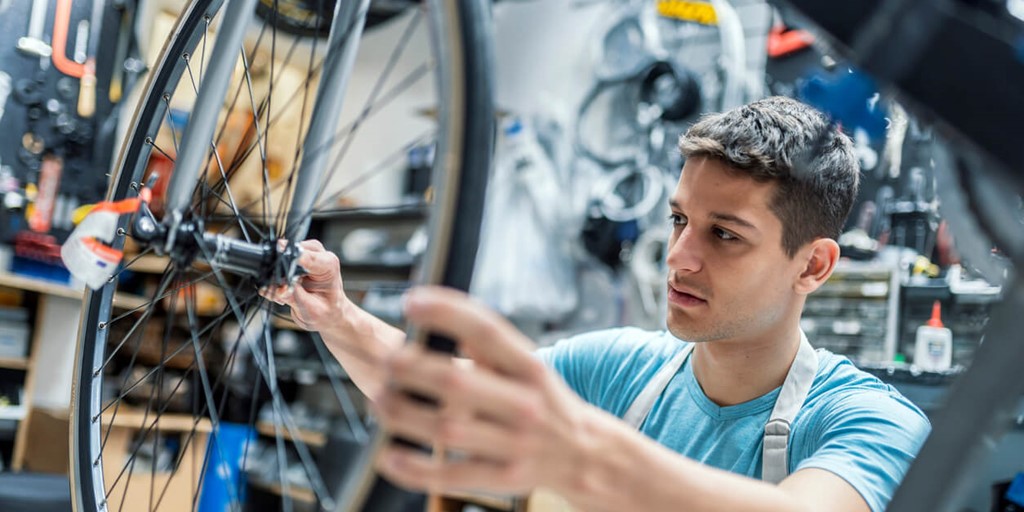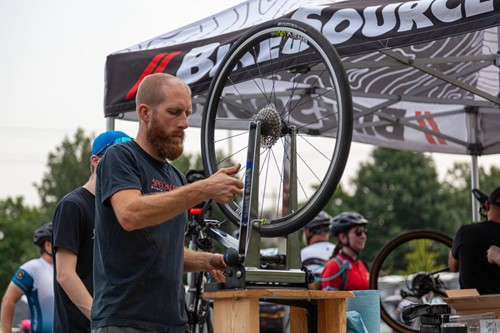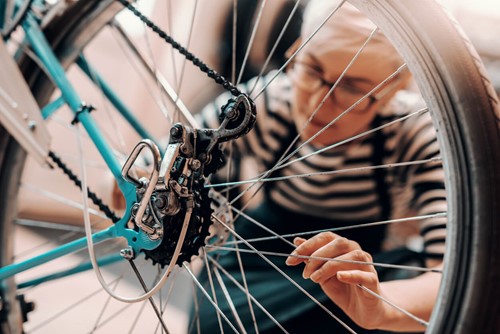How to true a bike wheel (step-by-step)

As a cyclist, you’ll probably need to know how to true a bike wheel at some point. After all, you understand better than anyone the importance of making sure all your bike’s components are in good condition and working order.
Table of contents
1. How to true a bike wheel with a truing stand
2. How to true a bike wheel without a truing stand
A well-looked-after and maintained bike means you’ll be able to get from A to B smoothly with minimal hiccups. But no matter how well you look after your bike and how careful you are when riding it, sometimes, maintenance time is unavoidable.
Regular use of your bike can cause the wheels to fall ‘out-of-true’. When this happens, it can cause your wheels to spin with a wobble—making the bike unstable, less predictable, and harder to control.
Out-of-true wheels pose various issues for cyclists. They can impact your bike’s braking performance and handling, and even slow down acceleration. Cycling accidents can also cause your wheel(s) to fall out-of-true.
How can you tell if a wheel is out of true?
One of the simplest ways to tell if your bike wheel is out of true is to lift the wheel off the ground and spin it. Pick one specific spot on the wheel to concentrate on as it spins. If you notice it wobbling back and forth, it’s out of true.
Related: 4 signs that your wheels need truing desperately
What does it mean to true a bike wheel?
If you true a bike wheel, it simply means you have adjusted its tension and alignment so that it spins evenly without any hops or wobbles.
This can normally be done by adjusting the spokes. You can true a bike wheel with or without a truing stand, but you’ll need a spoke wrench whichever way you choose.
How to true a bike wheel with a truing stand

As mentioned above, you can true a bike wheel with or without a truing stand. The process doesn’t differ too much either way, but let’s start by looking with the help of a truing stand.
1. Place the wheel in the stand
Start by placing the relevant wheel into the truing stand and securing it into position with the clamps available. You might find it easier to detach the wheel from the rest of the bike to do this (as pictured above), but it’s not essential. Wheels can usually be clamped into a stand, either attached or unattached to the rest of the bike.
Related: Best wheel truing stand reviews 2023 & buying guide
2. Gently spin the wheel
Once the wheel is secured, gently spin it, watching carefully as it turns. If the wheel bobs up and down, that’s a sign it needs radial truing—skip to the end section of this article if you’d like to read more about radial truing.
As the wheel spins, dial in the truing stand jaws until they start to touch the outer wheel rims on either side. This will help you locate the wheel’s buckle. Locate the centre of the buckle by rotating the wheel back and forth at the buckle point.
3. Pinpoint the relevant spoke
With the buckle located, you’ll be able to find the relevant spoke.
If the wheel is pulling to the left, the spoke you want is probably to the right-hand side of the wheel hub, near the centre of the buckle. If it’s pulling the right, the spoke will be on the left-hand side.
4. Adjust the tension and check the results
Grab your spoke wrench and adjust the spoke by tightening or loosening the nipples accordingly. Then, re-spin the wheel to check the results. You can continue to make further adjustments until you’re happy the wheel is spinning true.
How to true a bike wheel without a truing stand

The process of truing a bike wheel without a truing stand is largely the same.
1. Check the spokes
This first step is particularly handy if you’re out and about and want to try a quick fix.
Work your way around the wheel, grabbing pairs of spokes at a time, giving them a gentle squeeze. This will help you work out if any of them are loose—in which case, a quick tighten may do the trick.
2. Locate the buckle
If the above step doesn’t work, you’ll need to have a closer look at the wheel. In the same way you would do with a truing stand, gently spin the wheel, and identify which section is pulling out-of-true. Then, locate the relevant spokes depending on where the buckle is.
3. Adjust and check
Use your spoke wrench to adjust the nipples before re-spinning the wheel to check the result.
Truing a bike wheel is a relatively simple task, but perseverance and patience are often required before you achieve the desired result.
If your wheel is severely out-of-true—to the point where cycling is difficult, or you’re likely to damage your bike further, or have an accident as a result—it may be best to visit a professional bike mechanic to fix things for you.
What is the difference between radial and lateral truing?

Radial and lateral truing are two different types of truing used to correct different wheel issues.
If your bike wheel bobbles up and down when it spins, it probably needs radial truing. If your bike wheel pulls to one side, left or right, it probably needs lateral truing.
Radial truing involves adjusting the tension in the spokes running from the wheel hub to the rim, correcting any bobbles causing the wheel to move up and down as it spins.
Lateral truing involves adjusting the tension in the spokes on either side of the wheel, bringing the rim back into a straight line, meaning it’s no longer offset to one side and won’t wobble to the left or right as it spins.
Related: Wheel truing (lateral and radial)
Knowing how to true a bike wheel is useful for maintaining your bike’s long-term stability and efficiency. You’re more likely to damage your bike or have an accident if one of your wheels is ‘out of true’ for too long.
That’s why you may also want to consider protecting yourself with specialist cycling insurance.
With Cycleplan, you’re covered for theft, loss, and accidental damage up to £30,000. Policies can also be tailored to include Personal Accident and Public Liability cover to protect you if deemed liable for injury to someone else or damage to property while out on your bike.
Learn more about specialist cycling insurance here and get an online quote today.
Related
How to get bike oil & grease out of clothes (step-by-step)
How to tighten a bike chain (step-by-step)
How to remove bike pedals (step-by-step)







